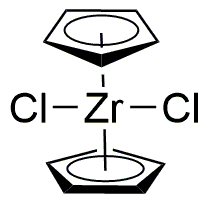Zirconocene dichloride is widely utilized in research focused on:
- Catalysis: It serves as a catalyst in various polymerization reactions, particularly in the production of high-performance polymers like polyolefins. This application is crucial in the plastics industry, where enhanced material properties are desired.
- Organometallic Chemistry: Researchers use it to synthesize novel organometallic compounds, which can lead to the development of new materials with unique electronic and optical properties. This is particularly valuable in electronics and materials science.
- Drug Development: In medicinal chemistry, zirconocene dichloride is explored for its potential as a drug delivery agent, offering targeted therapy options in cancer treatment. Its unique properties allow for improved efficacy and reduced side effects compared to traditional methods.
- Surface Modification: It is utilized in the modification of surfaces to enhance adhesion and compatibility in coatings and adhesives, benefiting industries such as automotive and aerospace.
- Research in Nanotechnology: The compound plays a role in the synthesis of nanomaterials, which are essential in various applications, including sensors and catalysts, providing advantages in efficiency and performance over bulk materials.
General Information
Properties
Safety and Regulations
Applications
Zirconocene dichloride is widely utilized in research focused on:
- Catalysis: It serves as a catalyst in various polymerization reactions, particularly in the production of high-performance polymers like polyolefins. This application is crucial in the plastics industry, where enhanced material properties are desired.
- Organometallic Chemistry: Researchers use it to synthesize novel organometallic compounds, which can lead to the development of new materials with unique electronic and optical properties. This is particularly valuable in electronics and materials science.
- Drug Development: In medicinal chemistry, zirconocene dichloride is explored for its potential as a drug delivery agent, offering targeted therapy options in cancer treatment. Its unique properties allow for improved efficacy and reduced side effects compared to traditional methods.
- Surface Modification: It is utilized in the modification of surfaces to enhance adhesion and compatibility in coatings and adhesives, benefiting industries such as automotive and aerospace.
- Research in Nanotechnology: The compound plays a role in the synthesis of nanomaterials, which are essential in various applications, including sensors and catalysts, providing advantages in efficiency and performance over bulk materials.
Documents
Safety Data Sheets (SDS)
The SDS provides comprehensive safety information on handling, storage, and disposal of the product.
Product Specification (PS)
The PS provides a comprehensive breakdown of the product’s properties, including chemical composition, physical state, purity, and storage requirements. It also details acceptable quality ranges and the product's intended applications.
Certificates of Analysis (COA)
Search for Certificates of Analysis (COA) by entering the products Lot Number. Lot and Batch Numbers can be found on a product’s label following the words ‘Lot’ or ‘Batch’.
*Catalog Number
*Lot Number
Certificates Of Origin (COO)
This COO confirms the country where the product was manufactured, and also details the materials and components used in it and whether it is derived from natural, synthetic, or other specific sources. This certificate may be required for customs, trade, and regulatory compliance.
*Catalog Number
*Lot Number
Safety Data Sheets (SDS)
The SDS provides comprehensive safety information on handling, storage, and disposal of the product.
DownloadProduct Specification (PS)
The PS provides a comprehensive breakdown of the product’s properties, including chemical composition, physical state, purity, and storage requirements. It also details acceptable quality ranges and the product's intended applications.
DownloadCertificates of Analysis (COA)
Search for Certificates of Analysis (COA) by entering the products Lot Number. Lot and Batch Numbers can be found on a product’s label following the words ‘Lot’ or ‘Batch’.
*Catalog Number
*Lot Number
Certificates Of Origin (COO)
This COO confirms the country where the product was manufactured, and also details the materials and components used in it and whether it is derived from natural, synthetic, or other specific sources. This certificate may be required for customs, trade, and regulatory compliance.


